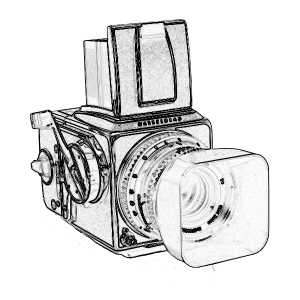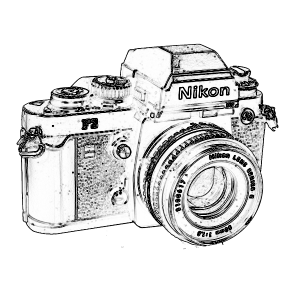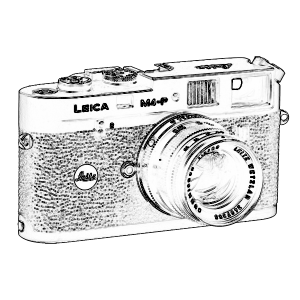
Hasselblad SWC Superwide - 1948
When the Carl Zeiss 38mm/f4.5 Biogon was introduced, in 1954, it was the widest-angle medium-format lens available at the time. The problem was that the rear element of the lens extended so far into the camera body, it couldn’t be used with any of the existing medium-format reflex cameras. Victor Hasselblad, not one to be stumped by technical issues, solved the problem by designing a dedicated non-reflex camera with a shoe-mounted optical viewfinder that approximated the Biogon’s 90-degree angle of view. He called it the Hasselblad Superwide Supreme and it proved to be the first of a series of five generations of Superwide SWC cameras that would remain in production for the next 50 years!
The beauty of the Superwide is its ability to capture wide-angle pictures that simply don’t look wide-angle. They’re wide-angle, but the Zeiss 38mm Biogon renders the spatial relationships between visual elements within the frame with less perceptual distortion than a comparable wide lens on a full-frame 35mm camera.
In terms of simplicity, Hasselblad’s Superwide is the quintessential camera. It contains zero electronics, so it never requires batteries. Its manual-focus lens isn’t coupled, so you have to set the focus by physically measuring the camera-to-subject distance or by guesstimating. For precision through-the-lens focusing, you can use the optional Focusing Screen Adapter, or if you want to make life easy, simply stop the lens down to f/22, set the focus to a bit past 5', and everything from about 26" to infinity will be tack sharp.
The SWC is the finest super-wide angle that I have ever used. It is a fixed lens affair that just keeps on giving. No distortion just perfection!
FILM:
I use both 120 and 220 rolls for the 6cm X 6cm square format.
Kodak Ektachrome 100 transparency (slide) film was my main choice for my American Visions. I also used on the rare occasion Kodachrome 25 for it’s deep color saturation!
Fujichrome Velvia 100 Fujichrome Velvia 50

Hasselblad CM - 1970
The real turning point for the company occurred in 1957. The 1000 F was replaced by the 500 C. The landmark 500 C design formed the basis for Hasselblad's product line for the next sixty years, with variants being produced until 2013. It was not until 1960, though, that Hasselblad's cameras became profitable; prior to this point, the company was still being entirely supported by sales of imported photographic supplies, including their distribution of Kodak products.
In 1962, NASA began to use Hasselblad cameras on space flights, and to request design modifications. The first motor-driven camera, the 500 EL, appeared in 1965 as a result of NASA requests. While Hasselblad had enjoyed a slowly but steadily growing reputation among professional photographers through the 1950s, the publicity created by NASA's use of Hasselblad products dramatically increased name recognition for the brand.
The 500C is a whole different experience from SLR or Leica’s rangefinder, because you are for the most part looking into the top of the camera while holding it from waist to chest high. But, once I got accustomed to this system and installed a ‘grid’ view finder, then the magic happened. I used it primarly with the 80MM Zeiss lens.
FILM:
I use both 120 and 220 rolls for the 6cm X 6cm square format.
Kodak Ektachrome 100 transparency (slide) film was my main choice for my American Visions. I also used on the rare occasion Kodachrome 25 for it’s deep color saturation!
Fujichrome Velvia 100 Fujichrome Velvia 50

Nikon F3 HP - 1980
The Nikon F3 HP was the third Single Lens Reflex (SLR) for this prestigious Japanese glass/optical/camera company!
Nikon F3 HP for the first time, shutter information was displayed via an internal liquid crystal display (LCD) inside the viewfinder. Aperture information was relayed through Nikon's "ADR" (Aperture Direct Readout) which was a small window at the top center of the viewfinder that got its Information from a micro-prism that read small numbers at the top of the mounted lens, of which type 'AI' (Aperture Indexing) or 'AIS' (Aperture Indexing Shutter Priority) lenses had printed behind the normal aperture numbers.
The Nikon F3 HP with it’s mega information (for the time) gave me the confidence to limit the number of exposures I made of a particular image. Keep in mind with film you had to wait until the film was developed before you could ‘proof’ your work! And like the Nikon F it afforded me the versatility to create the beginnings of a PenturaVision.
FILM:
Kodak Ektachrome 100 transparency (slide) film was my main choice for my American Visions. I also used on the rare occasion Kodachrome 25 for it’s deep color saturation!

Nikon F - 1959
The Nikon F camera, introduced in April 1959, was Nikon's first SLR camera. It was one of the most advanced cameras of its day. Although many of the concepts had already been introduced elsewhere, it was revolutionary in that it was the first to combine them all in one camera. It was produced until October 1973 and was replaced by the Nikon F2. Aspects of its design remain in all of Nikon's subsequent SLR cameras, through the current Nikon F6 film and Nikon D5 digital models (which still share its Nikon F-mount for lenses). The "F" in Nikon F was selected from the term "re-f-lex", since the pronunciation of the first letter "R" is not available in many Asian languages.
This workhorse of a camera was my first major buy in professional cameras. I loved the weight and balance in my hand and the number of Nikkor lenses was mind-boggling to me at the time.
Some of the legendary stories that were circulating at the time were from the press corps. One such story was of a photographer working in a helicopter and losing his F out the door of the in flight helicopter. They found the camera some time later and it was still working perfectly. True or False, I cannot say, but I did love carrying that story around with me while I was working on the beginnings of America.
FILM:
Kodak Ektachrome 100 transparency (slide) film was my main choice for my American Visions. I also used on the rare occasion Kodachrome 25 for it’s deep color saturation!

Leica M4-P - 1981
Conceived as a camera for professional use, the M4-P is in my opinion, the most rugged and functional of the M-series film cameras. Based on the design and construction of the M4-2 it featured several refinements including two additional usable bright-line viewing frames for 28mm and 75mm lenses. Introduced in 1981, a little over 22,000 were made before production ceased in 1987.
Included are a view frame pre-selection lever and motor drive. My standard lens complement are: 21 MM Super Angulon, Leica 35 MM Summicron, 50 MM Summicron and the venerable Leica 90 mm Summicron.
The Leica M4-P stayed in my camera bag for more than a decade, after which I moved into the digital domain by buying a Canon D-30 and D5 and finally the Leica M-9 and M-9P and then the Leica M-P Safari and Leica Monochrome all of which are still in use today!
FILM:
Kodak Ektachrome 100 transparency (slide) film was my main choice for my American Visions. I also used on the rare occasion Kodachrome 25 for it’s deep color saturation!
Fujichrome Velvia 100 Fujichrome Velvia 50 I started using in the Nineties and I used it for certain situations where I needed to saturate the color by underexposing. You had to be careful not to use Fujichrome for any exposures over 13 seconds, as all hell would break loose on the color scale front.

Leica M4-2 - 1977
Leica introduced this model in 1977 after many complaints about the ill-fated M-5. To cut cost Leica moved production from Germany to Canada and added the first motor drive and hot shoe for flash, but Leica discontinued the self-timer, which for me was not a good thing. It was lighter in the hand then the Leica M3, but in my opinion was not as rugged as the M3.
The Leica M4-2 only stayed in my camera bag for a short 2 years, after which I bought the mighty M4-P! But, while the M4-2 was in my hands I was able to capture some fine images with great optical discipline.
FILM:
Kodak Ektachrome 100 transparency (slide) film was my main choice for my American Visions. I also used on the rare occasion Kodachrome 25 for it’s deep color saturation!
Fujichrome Velvia 100 Fujichrome Velvia 50 I started using in the Nineties and I used it for certain situations where I needed to saturate the color by underexposing. You had to be careful not to use Fujichrome for any exposures over 13 seconds, as all hell would break loose on the color scale front.

Leica M3 - 1954
The Leica was introduced in 1954 it has a combination rangefinder and viewfinder in one eyepiece with a bright image. The rangefinder works by bringing a double image into a single one. The viewfinder has parallax compensation and shows the 50mm, 90mm and 135mm frame when the lens is mounted.
A rapid wind lever in 2 strokes transports the film. The film counter resets to 0 automatically when the take up spool is removed while loading the film.
Unlike the Leica III Series the shutter speeds are on one dial, either the shutter speed dial or the rewind knob rotate when advancing the film.
The M series Cameras take a quick-change bayonet lens mount and will accept the Leica screw mount lenses by using a M-Bayonet Adopter Ring.
The Leica M3 was a Rangefinder camera. I gave up the convenience of a SLR type of camera for the speed and superior optics of Leica. I was spending more and more time on the road in my search for America and needed a camera that could focus rapidly in all light situations. So after a learning curve of 6 months, I felt that I had mastered the art of using a Rangefinder camera.
FILM:
Kodak Ektachrome 100 transparency (slide) film was my main choice for my American Visions. I also used on the rare occasion Kodachrome 25 for it’s deep color saturation!
Fujichrome Velvia 100 Fujichrome Velvia 50 I started using in the Nineties and I used it for certain situations where I needed to saturate the color by underexposing. You had to be careful not to use Fujichrome for any exposures over 13 seconds, as all hell would break loose on the color scale front.
STATES
- Home
- About
- PenturaVision
- Contact
- ALABAMA
- ARIZONA
- ARKANSAS
- CALIFORNIA
- COLORADO
- CONNECTICUT
- DELAWARE
- DISTRICT OF COLUMBIA
- FLORIDA
- GEORGIA
- IDAHO
- ILLINOIS
- INDIANA
- IOWA
- KANSAS
- KENTUCKY
- LOUISIANA
- MAINE
- MARYLAND
- MASSACHUSETTS
- MICHIGAN
- MINNESOTA
- MISSISSIPPI
- MISSOURI
- MONTANA
- NEBRASKA
- NEVADA
- NEW HAMPSHIRE
- NEW JERSEY
- NEW MEXICO
- NEW YORK
- NORTH CAROLINA
- NORTH DAKOTA
- OHIO
- OKLAHOMA
- OREGON
- PENNSYLVANIA
- RHODE ISLAND
- SOUTH CAROLINA
- SOUTH DAKOTA
- TENNESSEE
- TEXAS
- UTAH
- VERMONT
- VIRGINIA
- WASHINGTON
- WEST VIRGINIA
- WISCONSIN
- WYOMING
INFO